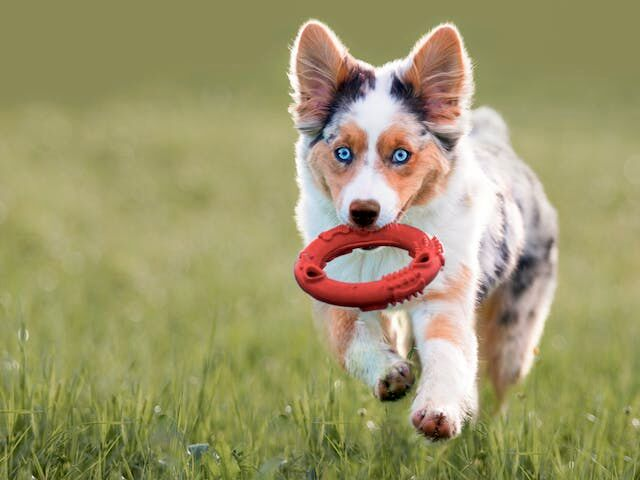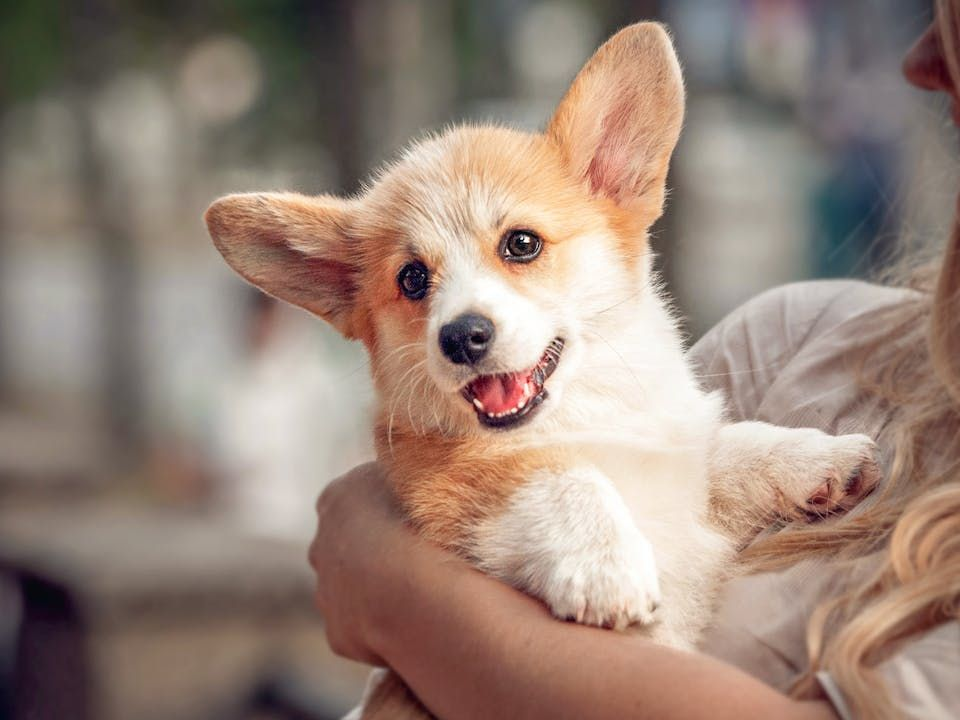How to prepare for your puppy's first walk
As eager as you are to introduce your puppy to the world outside, before you hook up that lead and head out the door, you can set your young puppy up for a positive experience. Walks should be fun for both of you, so some prep work before that first walk helps make future walks easy.
Dogs used to be very busy with herding and guarding, depending on the breed. Those activities provided exercise and mental stimulation to keep them well-balanced. Many of today's urban dogs lead a more sedentary life and need walks to keep them exercised and socialised. Walks allow dogs to use their natural instincts, like sniffing, exploring and interacting with different people and other dogs. Even if you have a garden and can let your dog out to explore, walks around the neighbourhood are an exciting adventure for your puppy!
Article

When can your puppy go outside for the first time?
Young puppies have immature immune systems and are susceptible to serious diseases like parvovirus and distemper. Until your puppy is fully vaccinated, use a secured pram or carrier to take them outside into the world. The smells, sounds and sights will fascinate and exhaust them even without their paws touching the ground.
Your puppy can venture outside with you (always supervised) into a secured area that no unfamiliar animals frequent. Taking your puppy out on a lead during toilet training or for short exploration adventures allows your puppy to get used to being on a lead from early on.

How long after their 2nd vaccination can your puppy go out?
To protect your puppy from disease, avoid walks until two weeks after they have all vaccinations. Immunity can vary by shot, so ask your veterinarian when the protection takes effect. Many puppies have their shots before they leave their breeder or shelter so make sure the breeder or vet has given you all their vaccination info before you take your new puppy home.
Your dog is ready for puppy training classes once they have had their first round of shots. The puppies in the class are all at the same vaccination level, so your puppy can learn socialisation and basic skills safely.
Get ready for your puppy’s first walk
When you head out walking with your puppy, they will eagerly explore all the unfamiliar smells and distractions. There are a lot of things you can do to make sure puppy walks are positive experiences.
During those early puppy walks, lots of tasty treats and verbal praise are essential. Find a quiet place to take your puppy walking. They can explore without the hustle and bustle of people and other dogs. Your puppy may pull on the lead or walk between your legs, getting you both tangled up, but with patience, your puppy will figure out your walking expectations. Praise your pup when they walk beside you and allow them to explore their new surroundings.
Three common mistakes to avoid on that first walk are:
1.
Going out before your puppy has become accustomed to walking on a lead
2.
Going too far or exercising too much
3.
Not prepping the way for a positive experience
Preparing your puppy for a successful first walk
Try baby steps first
Not all puppies will naturally accept a new collar or walk on a lead. Even the most fearless puppy can become overwhelmed and frightened by cars, loud children, and too many distractions around them. By choosing a quiet place that isn't busy, your puppy will more likely enjoy the adventure outdoors.
ID tags are necessary
All dogs need a collar with an ID tag carrying your name, contact information, and address. The collar should remain on your puppy, even if you also put on a harness. The harness is safer for young puppies. They don't damage tender neck muscles and are more comfortable.
Use redirection for distractions
When distractions pop up (like a squirrel), regain your pup's attention by calling them and reward them for choosing you over the squirrel.
Practice makes perfect!
Your puppy should walk on the lead without fighting it. Practise in the garden or the house before the walk so the puppy is comfortable with collars, harnesses or their lead. And your puppy most likely won’t master this on their first walk.
Let your puppy set the pace
Don't expect your puppy s walking pace to be consistent. Puppies explore with their eyes, ears, nose and mouth (although supervise what they plan to pick up). Walking can quickly become frustrating if you expect your puppy to walk calmly beside you on their first excursions outdoors.
Be prepared
Have a good supply of waste bags, water and treats to take with you if you are training. Remember to take them out of your dog s daily food portion!
Try baby steps first
Not all puppies will naturally accept a new collar or walk on a lead. Even the most fearless puppy can become overwhelmed and frightened by cars, loud children, and too many distractions around them. By choosing a quiet place that isn't busy, your puppy will more likely enjoy the adventure outdoors.
ID tags are necessary
All dogs need a collar with an ID tag carrying your name, contact information, and address. The collar should remain on your puppy, even if you also put on a harness. The harness is safer for young puppies. They don't damage tender neck muscles and are more comfortable.
Use redirection for distractions
When distractions pop up (like a squirrel), regain your pup's attention by calling them and reward them for choosing you over the squirrel.
Practice makes perfect!
Your puppy should walk on the lead without fighting it. Practise in the garden or the house before the walk so the puppy is comfortable with collars, harnesses or their lead. And your puppy most likely won’t master this on their first walk.
Let your puppy set the pace
Don't expect your puppy s walking pace to be consistent. Puppies explore with their eyes, ears, nose and mouth (although supervise what they plan to pick up). Walking can quickly become frustrating if you expect your puppy to walk calmly beside you on their first excursions outdoors.
Be prepared
Have a good supply of waste bags, water and treats to take with you if you are training. Remember to take them out of your dog s daily food portion!
How to train your puppy to walk on a lead
Your puppy should consider the lead and collar or harness safe and positive. The steps are gradual. Lots of praise make this learning experience a fun bonding time for you and your puppy.
How long and often should you walk your puppy?
Puppies have low stamina and will sit down and be done walking when they get tired. The distance and duration of walks depend on your puppy's physical condition, breed, and stamina.

Managing your duration
The rule of thumb for walks is five minutes for every month of your dog's age. So, three-month-old puppies can walk for 15 minutes. This gives a general idea, it’s not set in stone. An Australian Shepherd may not get tired as quickly as a Dachshund with their short legs, so watch for signs your puppy is getting tired. Signs of exhaustion are panting, licking lips, yawning, losing interest, and refusing to walk further. When this happens, you have gone too far and may need to carry your pup home.

Tracking your distance
The distance of your walk varies as well. A Golden Retriever with more energy will walk further than a small Yorkie. In their first year, puppies should go on short rather than lengthy walks. Tender paw pads can become sore, and underdeveloped joints can be damaged.
Before and after vaccinations: safety considerations and guidelines for walking your puppy
- Make sure your puppy's collar and lead are light and well-fitting. Harnesses cause less strain on their fragile necks. They are also more comfortable for your puppy.
- Keep an ID tag on the collar containing contact information such as your name, address and postal code. This is a legal requirement in some countries—but it’s always a smart idea. Attach the tag to the collar if you use a harness for walks.
- Be prepared with poop bags, treats if training (to be taken out of their daily food ration), water and a pet water bottle or portable water bowl.
- Practise good puppy walking habits in your garden or home before you venture outdoors for that first walk. Your puppy should remain by your side and walk with you.
- Progress, not perfection when puppies are learning new skills. Anytime your puppy does what you expect, reward them. Positive reinforcement training is the most effective training method for well-adjusted dogs.
- The importance of daily puppy walks isn't just about exercise. While it does burn some energy, it also stimulates their brains, provides fresh air, socialises them and builds confidence in new situations. Dogs who have not taken regular walks or been adequately socialised can become bored and resort to destructive behaviours.
- Can you take your puppy out after the first vaccinations? Yes and no. Your puppy has an undeveloped immune system and should not go for unprotected walks until two weeks after the 2nd vaccinations. Until then, take your puppy out using a carrier or secured pram and never put your puppy on the ground where unknown animals that may carry diseases might have frequented.
- There are opportunities to socialise your puppy before their vaccinations are complete. Puppy training classes are safe, controlled socialisation events because all the puppies are the same age and at the same vaccination level. So are playdates with one of your friends' dogs you know has current vaccinations.
- Retractable or longline leads are popular but not a good idea for dogs new to walking. Your puppy should consistently walk on a regular lead before you try a longline. Longlines allow puppies to explore further away from you and be out of reach in an unpleasant situation with other dogs or people.
- Large and giant breeds grow slower than smaller and toy breeds. They need short walks more frequently with minimal running to protect their growing joints and ligaments.
- Small breeds also need short walks. Consider the difference between the ground a German Shepherd can cover compared to a Maltese. The Maltese will struggle to keep up and get too tired. Adjust the walks to the size and energy level of your puppy.
- Pay attention to the weather. Hot surfaces can burn tender paw pads quickly. Cold or icy surfaces may cut your puppy's pads, cause frostbite, or wear them through, causing painful rawness. If you live in extreme weather conditions, a canine coat or set of dog boots may make walking more comfortable.
Walks are essential for the development of your puppy, both physically and mentally. Preparation before your puppy's first walk helps ensure the experiences and explorations your puppy craves are positive for both of you.
Related articles
Like & share this page

